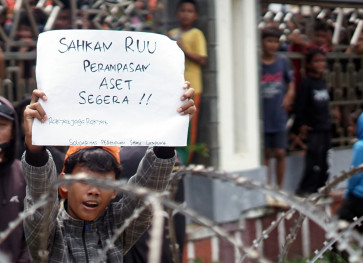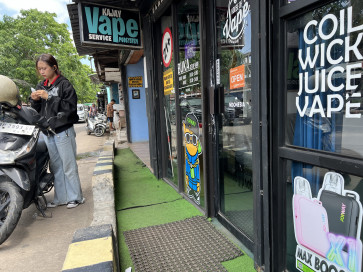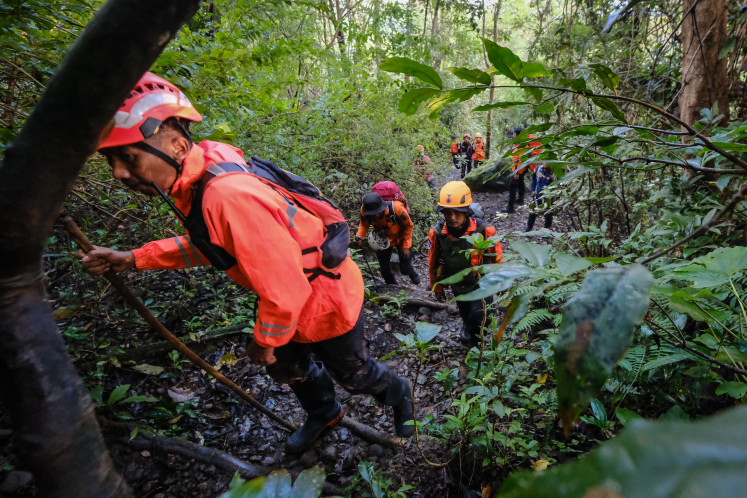Popular Reads
Top Results
Can't find what you're looking for?
View all search resultsPopular Reads
Top Results
Can't find what you're looking for?
View all search resultsExploring the colorful natural-dyed fabrics of Bali, Nusa Tenggara
Colors of life: Visitors look at traditional fabrics displayed at “Bali Nusra Tangi 2009” in Kuta, Bali, last week (photo above and photo right)
Change text size
Gift Premium Articles
to Anyone
C
span class="caption" style="width: 291px;">Colors of life: Visitors look at traditional fabrics displayed at “Bali Nusra Tangi 2009” in Kuta, Bali, last week (photo above and photo right). JP/Desy Nurhayati
Bali and Nusa Tenggara boast abundant creations of woven cloths dyed using plant extracts that not only produce beautiful long-lasting colors, but also outshine those created with chemical colorants.
The myriads of ethnic fabrics from villages across Bali, West Nusa Tenggara and East Nusa Tenggara took the center stage at the exhibition titled “Bali Nusra Tangi 2009” in Kuta, Bali, last week.
Although some of the fabrics were made between 75 to 100 years ago, they still exuded intense colors, such as the 100-year-old tais weto fabric from Manlea village in Belu regency, East Nusa Tenggara.
The hand-woven cloth, dyed using extracts of mengkudu (a small tree found in forests), still dazzles, with a deep red color dominating its stripe motif.
The Biboki sarong, made 75 years ago, shows a combination of deep indigo and red in stripe motif.
Women
in the country’s eastern province usually wear these types of fabrics
for major traditional ceremonies, including weddings and funerals.
Fabrics from East Nusa Tenggara have various motifs reflecting different meanings and levels in the society.
“Kings and queens usually wear the hinggi kombu. Hinggi means fabric, and kombu means mengkudu,” said Ignasio Hapukaranjawa, a native of Nusa Tenggara.
Fabrics with animal motifs are also widely used.
Rare skill: A native of Alor demonstrates how woven fabrics are colored, at the “Bali Nusra Tangi 2009” in Kuta, Bali. JP/Desy Nurhayati
“Horse and rooster motifs reflect the power of a king,” he said.
Another unique motif is the lobster, which depicts reincarnation.
“This motif reflects our belief that humans will live another life after their death.”
Other East Nusa Tenggara traditional fabrics displayed at the exhibition were the baranusa woven cloth originating from Alor, the 50-year-old sabu sarong from Sabu island, and the five-year-old Pahikung sarong from Rende, East Sumba regency.
West Nusa Tenggara also has its own Pahikung sarong made in Sumba regency, which has a different motif with a red and black dominant. Sumba’s laupahudu sarong, with its distinctive motif, was also on display.
Besides Nusa Tenggara fabrics, Bali’s famous gringsing cloth from Tenganan, as well as silk woven clothes made in Klungkung, Karangasem and Nusa Penida also drew the attention of visitors.
Nusa Penida offers kain cepuk and saudan cloths, and another type of woven cloth with a rectangular-shaped motif called rangrang.
JP/Desy Nurhayati
The coloring process takes several days, said Sariat Libana, a native of Alor who specializes in coloring threads.
“First, we extract the plants and soak the thread in the liquids. We use mengkudu to make the
red color, turmeric for yellow, and different kinds of leaves for the green color,” said the 40-year-old woman.
“If the color isn’t intense enough, we soak the fabric another seven times,” she said, adding that coloring silk threads took longer than cotton, because the dyes quickly faded when applied to silk.
Stunning fabrics from prominent designers — Samuel Wattimena, Oscar Lawalatta, Obin, Ghea Panggabean and Carmanita — were also on display during a fashion show held at the exhibition.
Each of the designers attempted to explore different aspects of the fabrics in their own style. Oscar made the most of East Nusa Tenggara’s woven clothes in his stunning designs by exploiting symmetrical motifs.
Carmanita chose to combine Balinese and East Nusa Tenggara woven cloths in her designs, adding many ruffles and layers at the seams.
Wattimena staged wide-cut, simple but attractive pieces of West Nusa Tenggara fabrics, while Ghea offered more complicated designs.












